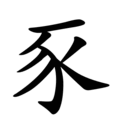Top Qs
Timeline
Chat
Perspective
豕
From Wiktionary, the free dictionary
Remove ads
See also: 豖
| ||||||||
 | ||||||||
| ||||||||
 | ||||||||
| ||||||||
Translingual
Alternative forms
There are typographical differences in this character in different fonts – in Japanese printing, the last two strokes may connect to the top stroke, as in right of 衣, while in handwriting and many other fonts, those strokes connect to the central curving stroke.
Depending on the font, the character 家 (Japanese) / 家 (Traditional Chinese) may also have either of these variations.
Han character
豕 (Kangxi radical 152, 豕+0, 7 strokes, cangjie input 一尸竹人 (MSHO), four-corner 10232, composition ⿱一𧰨(GHT) or ⿸𬺻⿸丿㇏(G) or ⿸𬺻⿱丿㇏(HT) or ⿸𬺻⿺㇏丿(JKV))
- Kangxi radical #152, ⾗.
Derived characters
See also
References
- Kangxi Dictionary: page 1194, character 4
- Dai Kanwa Jiten: character 36337
- Dae Jaweon: page 1657, character 1
- Hanyu Da Zidian (first edition): volume 6, page 3610, character 1
- Unihan data for U+8C55
Remove ads
Chinese
Glyph origin
Pictogram (象形) – a pig. Compare 亥, 𢑓 (male pig), and 豖 (castrated male pig). See also the original version on oracle bones of 敢.
Related to 㒸, in which however the pig is a phonetic component.
Etymology
Possibly from Austroasiatic (Schuessler, 2007). Compare Proto-Mon-Khmer *liik ~ *lik (“pig”) and Mon ကၠိက် (kloik, “pig”). Also occurs in the Cai-Long languages, from which Hölzl (2021) derives the name Ta-Li for the aforementioned language subgroup.
Pronunciation
- Mandarin
- (Standard Chinese)+
- Hanyu Pinyin: shǐ
- Zhuyin: ㄕˇ
- Tongyong Pinyin: shǐh
- Wade–Giles: shih3
- Yale: shř
- Gwoyeu Romatzyh: shyy
- Palladius: ши (ši)
- Sinological IPA (key): /ʂʐ̩²¹⁴/
- (Standard Chinese)+
- Cantonese
- (Standard Cantonese, Guangzhou–Hong Kong)
- Jyutping: ci2
- Yale: chí
- Cantonese Pinyin: tsi2
- Guangdong Romanization: qi2
- Sinological IPA (key): /t͡sʰiː³⁵/
- (Standard Cantonese, Guangzhou–Hong Kong)
- Hakka
- (Sixian, incl. Miaoli and Neipu)
- Pha̍k-fa-sṳ: chhí
- Hakka Romanization System: qiˋ
- Hagfa Pinyim: qi3
- Sinological IPA: /t͡sʰi³¹/
- (Sixian, incl. Miaoli and Neipu)
- Southern Min
- Middle Chinese: syeX
- Old Chinese
- (Baxter–Sagart): /*l̥ajʔ/
- (Zhengzhang): /*hliʔ/
Definitions
豕
- (obsolete) pig; boar
- 有豕白蹢、烝涉波矣。 [Pre-Classical Chinese, trad. and simp.]
- From: The Classic of Poetry, c. 11th – 7th centuries BCE, translated based on James Legge's version
- Yǒu shǐ báidí, zhēng shè bō yǐ. [Pinyin]
- There are many swine, with their trotters white, wading through the waves.
- 至攘人犬豕雞豚者,其不義又甚入人園圃竊桃李。是何故也?以虧人愈多,其不仁茲甚,罪益厚。 [Traditional Chinese poetry, trad.]
- From: Mozi, c. 4th century BCE
- Zhì rǎng rén quǎn shǐ jī tún zhě, qí bùyì yòu shèn rù rén yuánpǔ qiè táolǐ. Shì hégù yě? Yǐ kuī rén yù duō, qí bùrén zī shèn, zuì yì hòu. [Pinyin]
- As to seizing dogs, pigs, chickens, and young pigs from another, it is even more unrighteous than to steal peaches and plums from someone's orchard. Why? Because it causes others to suffer more, and it is more malevolent and culpable.
至攘人犬豕鸡豚者,其不义又甚入人园圃窃桃李。是何故也?以亏人愈多,其不仁兹甚,罪益厚。 [Traditional Chinese poetry, simp.]
Synonyms
- 亥 (hài) (zodiac)
Compounds
References
- “豕”, in 漢語多功能字庫 (Multi-function Chinese Character Database), 香港中文大學 (the Chinese University of Hong Kong), 2014–
Remove ads
Japanese
Kanji
豕
Readings
Korean
Hanja
- This term needs a translation to English. Please help out and add a translation, then remove the text
{{rfdef}}.
Vietnamese
Han character
豕: Hán Nôm readings: thỉ
- This term needs a translation to English. Please help out and add a translation, then remove the text
{{rfdef}}.
Wikiwand - on
Seamless Wikipedia browsing. On steroids.
Remove ads




